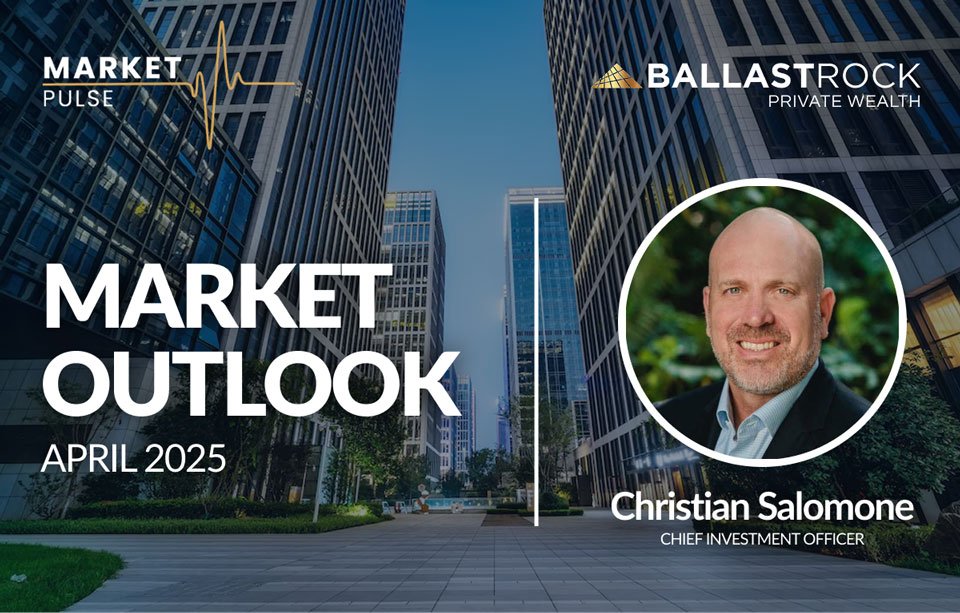April 2025 Market Outlook
The first quarter of 2025 was marked by significant volatility, largely driven by escalating trade tensions under the new U.S. administration and fluctuating expectations for Federal Reserve policy. The original tariffs levied on Canada, Mexico, and China compounded these challenges, as investors grappled with evolving dynamics and fragile market sentiment. After initially surging to record highs in January, the S&P 500 entered correction territory, declining by over 10% from its peak by the end of March. Concerns over broad-based tariffs and heightened geopolitical risks weighed heavily on investor confidence, contributing to ongoing volatility and uncertainty. These fears all came to fruition on April 2nd, when the administration took the market off guard by announcing tariffs significantly higher and broader than previous expectations before cutting them back to 10% on all countries except China. Since the announcement, all global equity indices have been extremely volatile as the market digests policy uncertainty.
Market Review
Even before the April 2nd tariff announcements, the first quarter of 2025 saw significant volatility and negative performance across major U.S. equity indices. Trade policy uncertainties, sticky inflation and DOGE cutbacks all overshadowed the post-election optimism that drove the market higher into the end of 2024. The S&P 500 declined by 4.6%, marking its worst quarterly performance since Q3 2022. However, the NASDAQ was hit hardest, dropping 10.5% amid heightened volatility in technology stocks, which were particularly sensitive to tariff-related concerns and shifting economic projections. The Dow Jones Industrial Average fared slightly better with a more modest decline of 1.3%, bolstered by defensive sectors such as energy, consumer staples, and utilities.
International equities, particularly in Europe, outperformed U.S. markets during the first quarter due to aggressive fiscal stimulus measures in Germany and other European nations, which were spurred on by a stark change in US foreign policy. However, fears of a global trade war saw both domestic and international indices sell-off significantly post April 2nd, before initially rebounding when the administration abruptly changed course.
The bond market provided some respite from equity losses. Investors sought refuge in bonds as concerns over economic growth, ongoing trade disputes, and potential stagflation increased. The 10-year U.S. Treasury yield ended the quarter at 4.23%, down from 4.58% at the beginning of the year. Bonds continued to rally in April, as investors continued the flight to quality and the likelihood of multiple Federal Reserve interest rate cuts increased. This changed after the tariff announcement when the long end of the curve sold off significantly due to fears around the stability of the US economy sending the 10-year yield briefly above 4.5%.
The Fed and Looking Ahead
As expected, the Federal Open Market Committee voted to keep interest rates unchanged at 4.25%–4.50% during its March meeting. However, the committee warned that economic growth may slow in 2025, while inflation could exceed prior expectations. At the time, markets anticipated two rate cuts in the second half of the year, but Chairman Powell emphasized the Fed’s readiness to act should conditions deteriorate further. The April 2 tariffs have only heightened these concerns. Economists now estimate that tariffs could add between 0.5% and 1.5% to inflation, while reducing U.S. GDP by a similar margin and increasing unemployment. As a result, markets are now pricing in four rate cuts in 2025, with the first potentially arriving as soon as May. Still, the Federal Reserve faces a policy dilemma: monetary easing may support growth and employment, but is ill-suited to combat tariff-driven inflation, while tightening to contain inflation risks worsening an economic slowdown.
Volatility Corner – “Liberation Day”
The April 2nd “Liberation Day” tariff announcements triggered a sharp sell-off in global stock markets and fueled a dramatic spike in equity market volatility. As shown below, this marks the second time in less than a year that the CBOE Volatility Index (VIX) has surged above 60, underscoring the market’s heightened sensitivity to trade policy shifts.
As we noted following the August spike, the journey from 15 to 65 on the VIX and back to 15 occurred over just 18 trading days, during which the S&P 500 dropped nearly 10% before rallying to a new all-time high by mid-September. Unlike the well-defined causes of the August disruption—primarily the unwind of Yen carry and index dispersion trades—we suspect this time may be different.
One of the critical dynamics we are monitoring is the shape of the VIX futures term structure and the spread between the spot VIX and those futures contracts. Typically, when equity markets are bullish, the term structure slopes upward, with the spot VIX sitting below all of the contracts. However, as shown below, the futures are currently in backwardation (downward sloping), with the spot VIX trading at a significant premium. While an equity market rebound is possible from current levels, the term structure must return to a more normalized state before we can sound the “all-clear.”
Maintaining a diversified portfolio across asset classes remains essential for navigating today’s market volatility. Staying invested and avoiding reactionary decisions during periods of uncertainty continues to be a cornerstone of long-term success, particularly as geopolitical tensions and heightened tariff uncertainties play out.
Each investor's risk tolerance and objectives are unique, so we encourage you to consult with your financial advisor, especially during these turbulent times, to assess how this information might affect your overall investment strategy.
For more information, please email us at contact@ballastrockpw.com should you have an questions.



